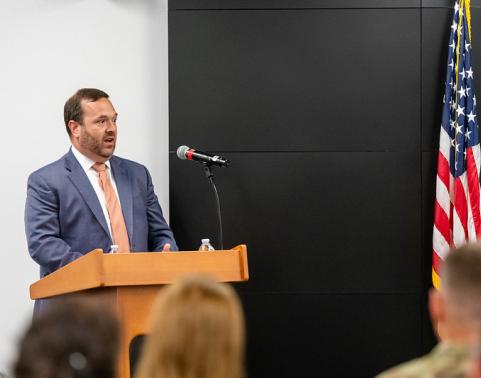From GFEBS to GFIM: applying Agile lessons learned

Rob Porter, the new product director at Program Executive Office Enterprise Information Systems’ (PEO EIS) Global Force Information Management (GFIM) product office, is no stranger to Agile.
When Porter first joined PEO EIS’s General Fund Enterprise Business System (GFEBS) product office as deputy product director in early 2020, the GFEBS team was just getting started in its transition from using traditional waterfall to a Scaled Agile Framework software development approach. The team, together with the Army’s functional sponsor and an industry vendor, had jointly decided that problems they were facing with one of their implementations could be resolved by adopting Agile.
Transforming into an Agile organization was not an overnight process, however. According to Porter, it took a good three-and-a-half years to fully change the organizational culture and become a high-functioning program office within PEO EIS’s Defense Integrated Business Systems (DIBS) portfolio.
“The first year was tough,” he said. “It involved lots of learning and growing as a collective team.”
In the long run, however, the transformation was well worth it in Porter’s eyes due to the “wildly successful” delivery of capabilities to the functional and end user. By using Agile, GFEBS has increased its throughput by processing a higher dollar amount of transactions than ever before, improved program budget execution and performance, and performed better with fewer problems and defects. The GFEBS team also managed to negotiate a better contract with the Army Shared Services Center, where it migrated its sustainment activities in early 2022 after moving to the cloud in summer 2020.
“In my honest opinion, the Agile transformation was an even bigger win for GFEBS over the last four years than the cloud migration was,” said Porter.
Now that he’s moved to a different PEO EIS portfolio — Army Data and Analytics Platforms (ARDAP) — to lead GFIM, Porter sees an opportunity to implement a similar Agile structure in a shorter amount of time.
“Now we have a leg up,” said Porter. “Leadership knows and buys into an Agile approach, and it’s a priority. Several programs have begun implementing it, and program successes help build on our knowledge base.”
While GFIM already kicked off Agile activities under former product lead Richard Eva, Porter plans to refine and mature the practices as the product office takes on a new scope of work — consolidating a data lake, analytical tool and transactional system to the GFIM Objective Environment. The functional community will become more involved in the development work, and the team will be able to push out capability faster, said Porter.
“Organizational culture has been a big thing for me,” said Porter. “There are some similarities between activities at GFEBS and GFIM. In both cases, we need good buy-in and engagement from the functional,” he said.
Industry engagement is also important, he noted. Porter is looking forward to meeting with industry vendors and to talk and share about the Army’s Agile approach.
“We need more industry engagement,” said Porter. “Most importantly, we need to tell them to come with a good understanding since we’ve gotten smart on Agile.”
Related News
-
Onedia James: a logistician and leader with a family legacy of service
April 22, 2025Onedia James recently stepped into the role of acting deputy project manager for Army Data and Analytics Platforms (ARDAP) at U.S. Army Program Executive Office (PEO) Enterprise, where she helps oversee and support the data portfolio’s four programs. -
ATIS rolls out additional capability, product enhancements to Soldiers
January 14, 2025On Jan. 8, the Army Training Information System (ATIS) team released the latest update to their Army Training Management Capability (ATMC) applications suite. -
Soldier-centered design drives development of ATIS training management software
December 6, 2024U.S. Army Program Executive Office (PEO) Enterprise’s Army Training Information System (ATIS) product office recently completed the first of three software previews, enabling around 700 Soldiers to input data and provide feedback that’s being incorporated into future iterations of the Army’s training management software.
Work for Us
Join a winning team! Search for job opportunities with PEO Enterprise.
Work with Us
Help support important missions. Explore ways your company can work with PEO Enterprise.